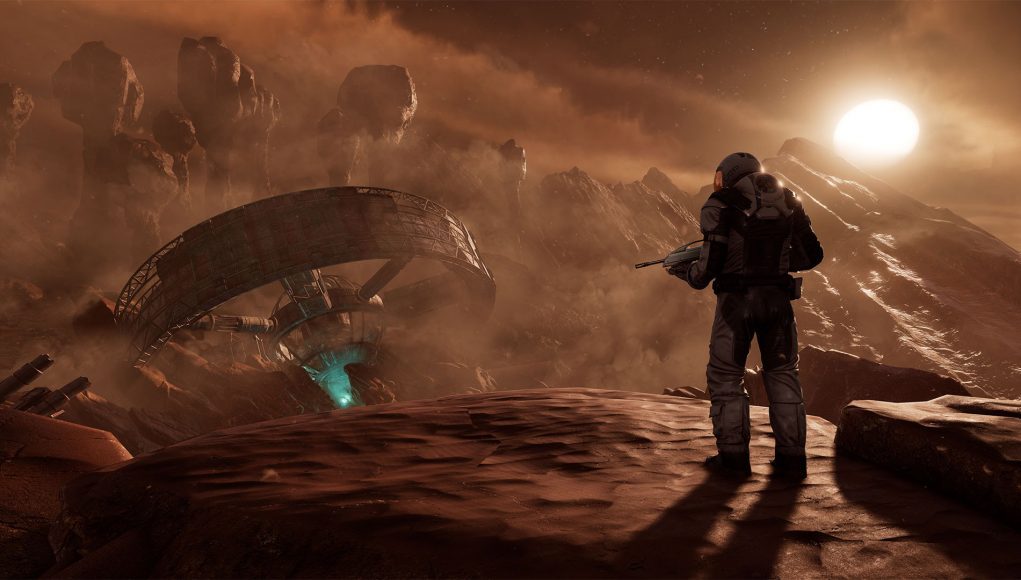Sony’s new VR peripheral, the PSVR Aim, launches today alongside Farpoint, a sci-fi VR FPS that was specially made with the controller in mind. Those who have been PlayStation fans for many years will remember that this isn’t the first time the company has made a gun peripheral, and those prior attempts didn’t see much success. Can Farpoint and PSVR Aim avoid repeating history? Read on to find out.
Farpoint Details:
Developer: Impulse Gear
Publisher: Sony Interactive Entertainment
Available On: PlayStation Store (PlayStation VR )
Reviewed On: PlayStation VR + Aim on PS4 Pro
Release Date: May, 16 2017
Gameplay
Farpoint opens by introducing players to two astronaut scientists around which the game’s story will revolve. Meanwhile the player inhabits a male character who does a lot more shooting than talking. The opening sequence sets up the mission of the astronauts: study a strange space anomaly.
And we all know what happens with strange space anomalies…. In this case it’s a destabilization of the anomaly which becomes a wormhole and sucks our two astronaut friends inside, along with the player who is piloting a shuttle that was on its way to pick them up. Oh, and the big space station they were stationed on gets pulled in too, presumably with all the crew on board. It all sounds pretty cliche (and it is), but actually it’s relatively well produced and the novelty of VR made it a pretty cool starting point for Farpoint.
After getting sucked inside you’ll find yourself plummeting toward a planet of unknown origin, the alien life of which you’ll soon get to know pretty well. Ejecting in an escape pod let’s you survive the landing on the planet’s surface—which resembles a more rocky mars with some active volcanoes—and you’ll set off on foot to search for those missing astronauts, and any other survivors who might have been inside. Thank the person who decided to make sure the escape pods come equipped with an assault rifle—you’re gonna need it.
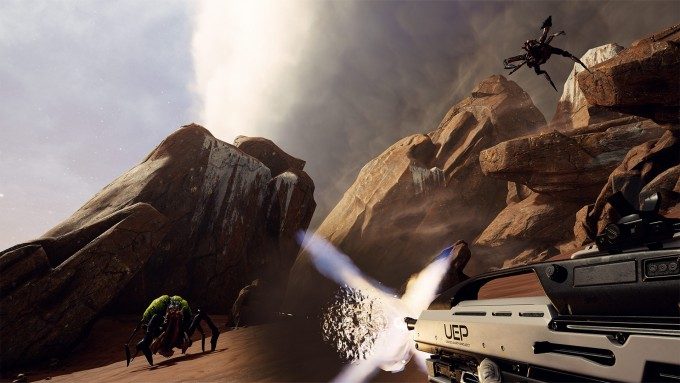 As you wander forward looking for signs of wreckage and hopefully survivors, you’ll quickly come to find a holographic beacon of sorts which you can scan to reveal a short holographic recording. Such holographic recordings act as breadcrumbs of the game’s story to keep you trodding along.
As you wander forward looking for signs of wreckage and hopefully survivors, you’ll quickly come to find a holographic beacon of sorts which you can scan to reveal a short holographic recording. Such holographic recordings act as breadcrumbs of the game’s story to keep you trodding along.
There will be lots of trodding; the vast majority of the game will involve you walking from one place to the next and battling enemies along the way. This continuous stick-based locomotion is a departure from most VR games today which use teleportation or another method (like being designed for no movement at all, like Job Simulator). The game doesn’t offer other methods for getting around, but the movement has been carefully designed to maintain comfort, and I was very surprised to find that it didn’t make me nauseous, even for play sessions of an hour or more. I talk more about the locomotion in the ‘Comfort’ section of the review below.
Anyway… now that you’re walking along… you’ll find that the planet’s inhabitants are instantly hostile, you can tell by the way they like to scream as they fling themselves at your face; the first foes you met are nasty little spider monsters which will be very familiar to anyone who has fought Half-Life’s ‘headcrabs’, and though the face-sucker enemy is a well worn sci-fi trope, I can promise you that you will be afraid to see a writhing, screaming, basketball-sized spider-monster flying at your face. What I mean to say is that VR makes these enemies frightening at an instinctual level.
Luckily your assault rifle (which has infinite ammo but can overheat) is up to the task. A holographic scope on top has a convincing look to it where the reticle will fade out if you aren’t looking straight down it. And look straight down it you will: there’s not a lot of hip-shooting in this game and you’ll be encouraged to make your shots count.
Thankfully, wielding a two-handed gun like the assault rifle feels very natural with PSVR Aim. All the guns in the game are designed to make sure your virtual hands are placed roughly where they should be on the aim controller, offering a convincing sense of holding the weapons within the game world. This is backed up by the subtle detail of clicky-clacky sound effects when you move the gun around, as well as the faint creaking of your thick space suit.
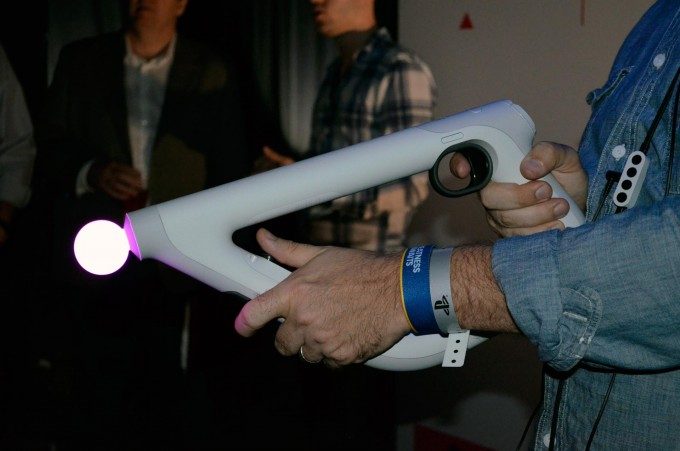
Although I was worried about the lack of a shoulder-rest on the Aim controller (meaning you need to hold the gun out in front of you with no support) I ultimately found the game very playable with its design, which seems to have been especially made to make it easy to get your head down to look through the weapons’ scopes without bumping the headset on the controller. This was achieved quite effectively as I don’t recall bumping my headset on the gun even once, and peering down the scope of each gun was easy.
The weapon mechanics are well made. Weapons feel functional and utilitarian without being simple laser pointers of destruction. You can only hold two guns at a time; a gesture whereby you raise your weapon to the side of your head is a quick and immersive way to change between your two guns. You’ll find a standard set at first: assault rifle, shotgun, long rifle, and a few more interesting ones later in the game (though you’ll likely have at least one of the initial three because they are quite flexible). The assault rifle and shotgun each have secondary fire modes which shoot explosives (rocket for the assault rifle, grenade for the shotgun) which bumps up their utility. Since the guns feel so physical, I would have liked to find some upgrades here or there to improve them over time (maybe a better scope that I get to physically attach, or a larger clip, etc), alas the weapons remain static throughout the game.
Opposite your weapons are a number of different different aliens. Early on it’s bug-type creatures you’re fighting which range in size from the little basketball-sized headcrabs I described earlier all the way to truck-sized chargers (and occasionally beyond). Each enemy attacks differently and is best dispatched using different weapons and different tactics.
That means that if you’re battling say, a field full of headcrabs, you’ll want your shotgun handy. If it’s a field full of headcrabs and the mortar-style yellow-back beasts which lob giant projectiles at you, you’ll want your assault rifle to be able to shoot the incoming mortars and get range on their origin while also dispatching headcrabs. With several enemies types at play in one battle, you’ll need to be on the lookout for danger coming from the sky, ground, and sometimes even underground.
Later in the game there’s a shift in the type of enemies you fight and things change fast. I don’t want to spoil much, but I can say that you will come to favor a different set of weapons and your foes will have significantly different tactics.
Ultimately Farpoint has a well made combat sandbox of weapons and enemies; it’s fun to shoot and kill things, and often times fun (or more accurately, frightening) to be shot at. More than once I found myself involuntarily physically bracing for impact as I saw a mortar coming down on my head. And I’m telling you, the spider creatures flying at your face are as scary as they are satisfying to blow away with a shotgun as the last moment.
The weapons are functional, but they always seem to leave the player feeling just a little bit underpowered compared to the threats at hand; this is reinforced by the sound design on the weapons that makes them feel further like they don’t pack that much punch. Occasionally you’ll briefly feel like you have the right tool for the job, but then the enemies will change things up and you’ll be right back to feeling like you’re just able to scrape by with what you got. That makes sense thematically for the game, but I think it would have improved the game to have occasional moments of significant firepower where you get to feel like for once you have the upper hand.
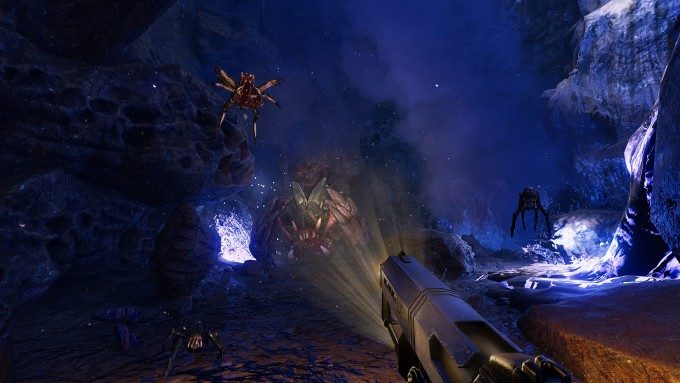 So it’s a lot of relatively satisfying run-and-gun. Sadly there’s essentially no environmental interaction; you won’t push any buttons or pull any levels, or cause the environment to react in any significant way. In fact, there’s no reason to shoot at anything except for enemies, and the PSVR Aim exclusively takes the form of a gun.
So it’s a lot of relatively satisfying run-and-gun. Sadly there’s essentially no environmental interaction; you won’t push any buttons or pull any levels, or cause the environment to react in any significant way. In fact, there’s no reason to shoot at anything except for enemies, and the PSVR Aim exclusively takes the form of a gun.
Intertwined with the gunplay is both the holographic recordings and more significant cutscenes involving the two astronauts from earlier who we find are alive but standed on the planet. Most of the game involves tracking the path of Eva, the female astronaut, to try to catch up to her so that you can regroup and form a survival and escape plan.
Fairpoint’s single player campaign took me a little over five hours to complete. And while in the traditional world of gaming that’s on the shorter end of things, for VR it’s quite substantial. It’s tremendously refreshing to come to a climactic moment, which would easily be the end of some other VR game—many of which last for only one or two hours—and have the game actually keep going and the story continue to develop.
The solid production values of Farpoint, along with its quality combat sandbox, and enough of a story to keep things moving along, make the game feel like one of the most complete single-player VR experiences on any platform to date, and surely a must-play for PSVR fans, so long as you’re into FPS gameplay.
Immersion
It seems almost silly, but simply holding a tracked-prop that roughly matches the objects you’re holding in VR can be a serious immersion booster. That’s exactly what the Aim controller does, and it also rumbles to offer some nice additional feedback.
Wielding the game’s weapons feels very natural thanks to the Aim controller, and you’d be smart to keep those weapons held tight to the chest.
Farpoint is downright challenging, and occasionally unforgiving. Every enemy in the game is potentially deadly, even the headcrabs (especially when you don’t thin their numbers sufficiently). Which leads to a constant sense of danger which immerses you deeply in the game.
The game uses sound as a crucial signal to alert the player to enemies, and the positional audio feels very accurate. Because of the deadliness of the enemies, you’ll be on edge throughout; every creak and groan of the environment will perk your ears and make you swing in that direction with your weapon at the ready.
Details large and small make Farpoint a very immersive game, though the strings of immersion are unfortunately regularly broken due to the tracking limitations of PSVR. The game is pushing the system’s tracking capabilities to its limits, and you will occasionally see those limits broken (more on this in the Comfort section).
Impressive graphics and detailed sound design help to build a world around you, and so too do interesting and aggressive enemies. At one point in the game you’ll meet an enemy that shoots a high-powered instant-kill laser at you and you may find yourself recoiling in fear as it nearly skims your head.
When it comes to small details, at one moment in the game I was confronted by a character at gunpoint who asked me a question. Although shaking your head yes or no was not a mechanic introduced anywhere in the game, I instinctively nodded to answer. It was ultimately a trivial moment, but I was delighted to find that it actually worked, and it definitely reinforced my belief in the world that I was standing in.
Unfortunately, beyond a pretty environment and strong visual and audio details, the planet and its inhabitants felt somewhat hollow despite their deadliness. Sure, the enemies are fun to fight, but you never learn anything about them, or about the planet you’re on. The enemies are just… enemies. And the planet is just ground and obstacles for you to fight through.
And while there’s some serviceable character development, the character you actually interact with is someone who you know little about (making it especially hard to infer their motivations), which makes the choice to spend so much time developing the other characters quite odd.
Comfort
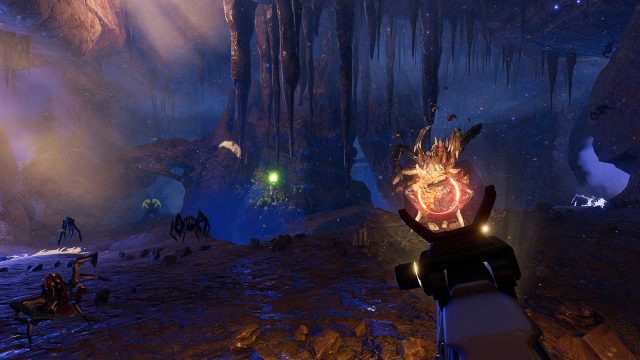 I’ll come out of the gate and say that I am surprised to report that (for me) Farpoint was comfortable from start to finish. I say I’m surprised because continous stick-based locomotion is generally regarded as a bad design choice for moving players through virtual environments. The key, it seems, is relatively slow movement and no artificial turning.
I’ll come out of the gate and say that I am surprised to report that (for me) Farpoint was comfortable from start to finish. I say I’m surprised because continous stick-based locomotion is generally regarded as a bad design choice for moving players through virtual environments. The key, it seems, is relatively slow movement and no artificial turning.
It’s abundantly clear that the game was made for comfort from the ground up. Throughout the game you’ll cover a lot of ground, but the entire world is designed such that you’re almost only ever walking directly forward or at 45± degrees off-center from forward.
The direction you walk is thoughtfully determined by the direction of your controller rather than your head, which I liked immensely because it meant I could look off to the sides to admire the world (or scan for enemies) while walking in a different direction; the more technical among you will know this as ‘decoupled’ movement.
By default, any artificial turning is disabled which might seem like an odd choice, but for the most part you can navigate the game entirely without artificial turning (and I would say this is actually recommended so that your forward position stays where the developers intended it). Turning around completely was clearly not meant to be part of the game, as the turning options just make for clumsy navigation; the only time you’ll feel the need to do so is when you’re occasionally falling back for cover or trying to kill an enemy that got behind you.
The enemies are pretty clearly designed to come at you from the front and kindly wait until you are looking at them to attack you, which helps eliminate the need to turn around. I actually found it so awkward to turn around artificially that I preferred to simply walk backwards or physically turn at an extreme angle to walk backwards in most cases. And although it happens rarely, it’s still frustrating and discomforting to need to make large movements backwards in the game, not only because you don’t know exactly what’s behind you, but it’s just awkward to need to retreat at a diagonal (to your forward position) but be largely required to stay facing forward.
The game isn’t very instructive as to how it expects players to stand or orient themselves to best play the game. I happen to understand the way the tracking works so I think I utilized the system mostly as intended, but not every player might understand how they are supposed to interact with the game, potentially leading to occlusions and frustration.
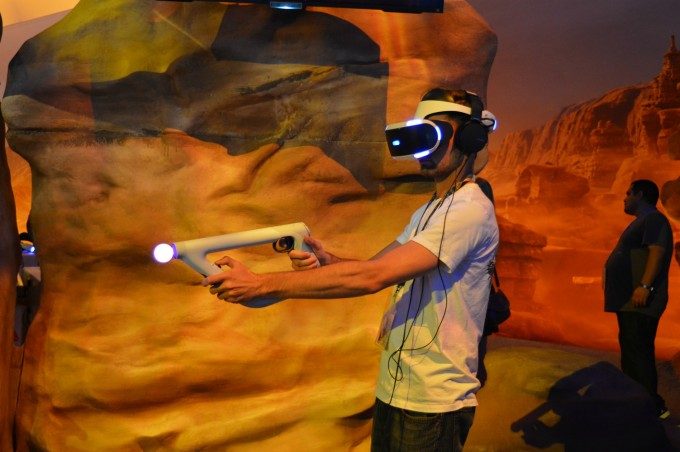 Sony has made a big deal in its marketing of the PSVR Aim controller about the “precision,” but the irony is that, while the shape of the device offers a good platform for a VR weapon, it doesn’t feel any more precise than the Move controllers. And that makes sense as it’s fundamentally based on the same tracking tech. And while I’d venture to guess that there’s some improved IMUs inside the Aim controller compared to the 7 year old Move controller, it doesn’t seem to be helping.
Sony has made a big deal in its marketing of the PSVR Aim controller about the “precision,” but the irony is that, while the shape of the device offers a good platform for a VR weapon, it doesn’t feel any more precise than the Move controllers. And that makes sense as it’s fundamentally based on the same tracking tech. And while I’d venture to guess that there’s some improved IMUs inside the Aim controller compared to the 7 year old Move controller, it doesn’t seem to be helping.
I’d say the Aim works reasonably well about 90% of the time. 8% of the time the virtual gun will drift several degrees in horizontal rotation compared to the real controller. The result is that the barrel of the virtual gun and the real controller are misaligned, which leads to the player needing to hold the gun at slightly awkward angles to compensate for the drift in the midst of combat. The remaining 2% of the time is prone to extreme drift where the gun rapidly drifts out of place and doesn’t stop:
You’re supposed to be able to calibrate things by holding the Options button, but this didn’t seem to work for me and only ever resulted in a quick flash of a view showing the virtual PS camera and its bounds. It seemed at times like shaking or swinging your gun around could fix the drift, but other times didn’t seem to help at all. There were times when I wanted to quit and restart the game because of how much the drift was impacting my aiming.
I will say that developer Impulse Gear has done an excellent job of designing a VR FPS around the limitations of PSVR’s tracking system, but even the very best content design can’t fix the underlying imprecision that feels only just good enough for serious VR gameplay.

